Abstract
OBJECTIVE: To validate an incremental field walking test, the shuttle walking test, as a means of assessing pacing modes and to aid programming of rate responsive pacemakers. DESIGN: Three separate groups of patients were recruited. Reproducibility (n = 10) of the shuttle walking test was assessed by performing three consecutive tests. Comparison of the shuttle walking test with a 10 min walk was assessed in 20 patients. In the third group (n = 10) patients with rate responsive pacemakers were programmed to either VVI fixed rate 70 beats/min or VVIR with the optimal rate response to show the discriminative value of the test. SETTING: Pacing clinic in a regional cardiothoracic centre. PATIENTS: 30 patients with chronotropic competence and dual chamber pacemakers with varying functional capacity and 10 patients with rate responsive pacemakers. INTERVENTIONS: Continuous haemodynamic monitoring was obtained using an ambulatory nuclear monitor, the Capintec VEST. Two exercise tests either shuttle walking test or 10 min corridor walk. The shuttle walk is an incremental walking test conducted on a 10 m course where the walking speed is dictated by bleeps on an audio cassette. RESULTS: Reproducibility was demonstrated over three consecutive tests with mean (1 SD) exercise times of 7.6 (1.7) min, 7.7 (1.6), and 7.7 (1.7) min. During the shuttle walk the test patients walked for a mean of 8.3 (1.2) min producing peak relative cardiac outputs of 78 (21) end diastolic volume/min compared with 64.9 (17) end diastolic volume/min for the 10 min walk (P < 0.001); peak heart rates were 118 and 104 beats/min (P < 0.03) respectively. In the third group relative peak cardiac output was significantly greater in VVIR (70 (24) v VVI 52 (15) end diastolic volume/min) (P < 0.009) as were exercise times (VVIR 8.8 (1.3) min v VVI 8.1 (1.3) min) (P < 0.003). CONCLUSIONS: The shuttle walk is an easy test to administer, requiring little equipment. It produces a symptom limited maximal performance and will be a useful aid to pacemaker programming as it is reproducible and able to show differences in exercise capacity between pacing modes.
Full text
PDF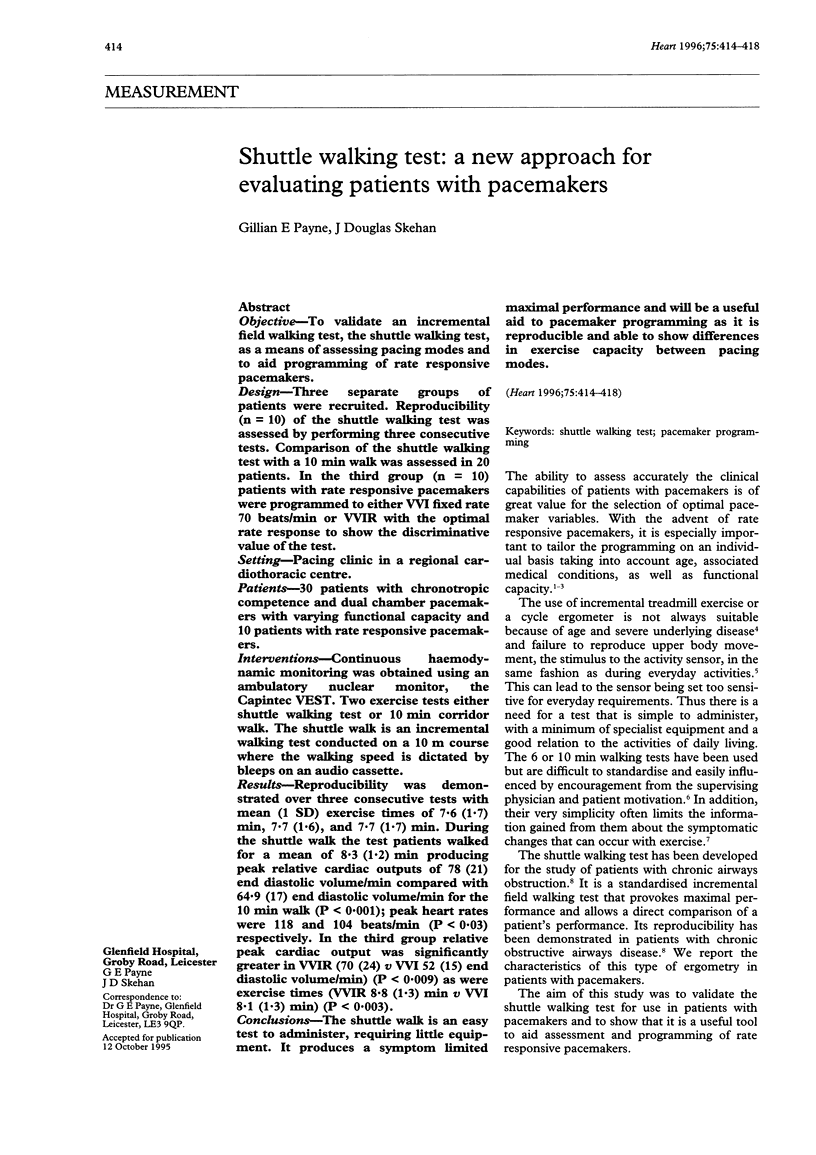
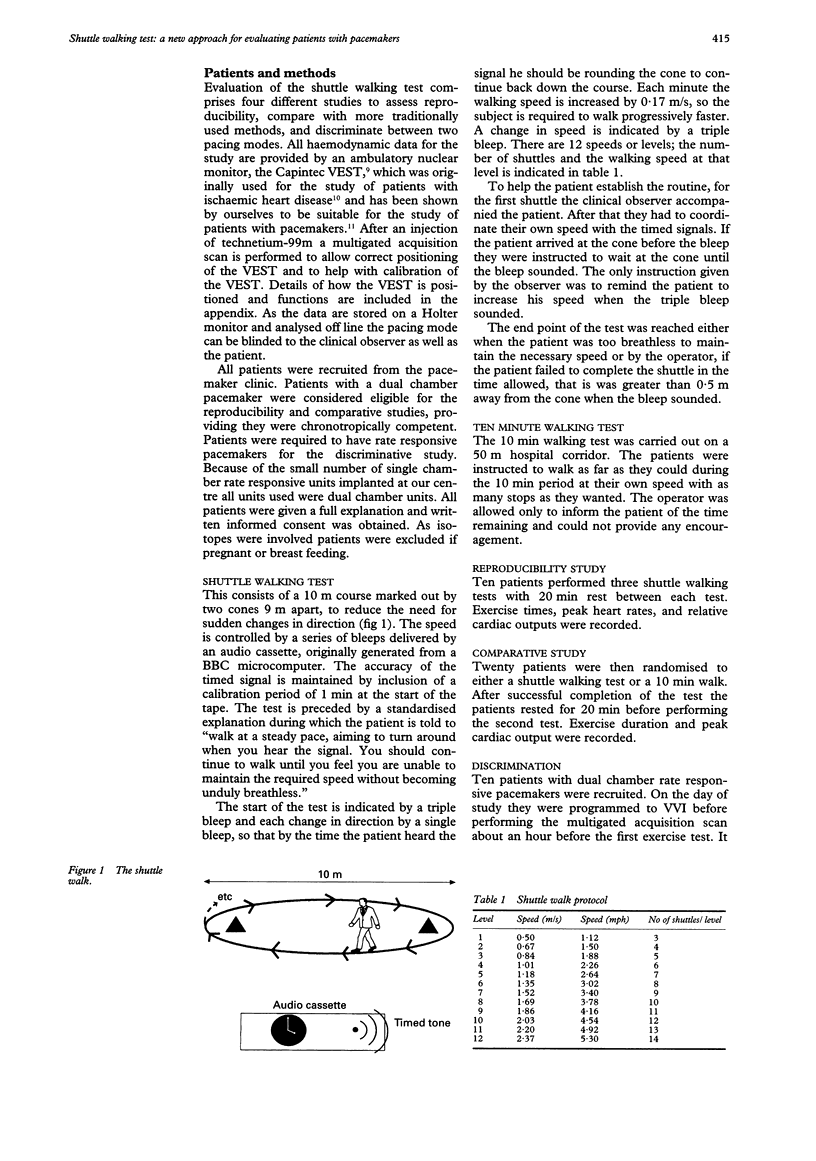
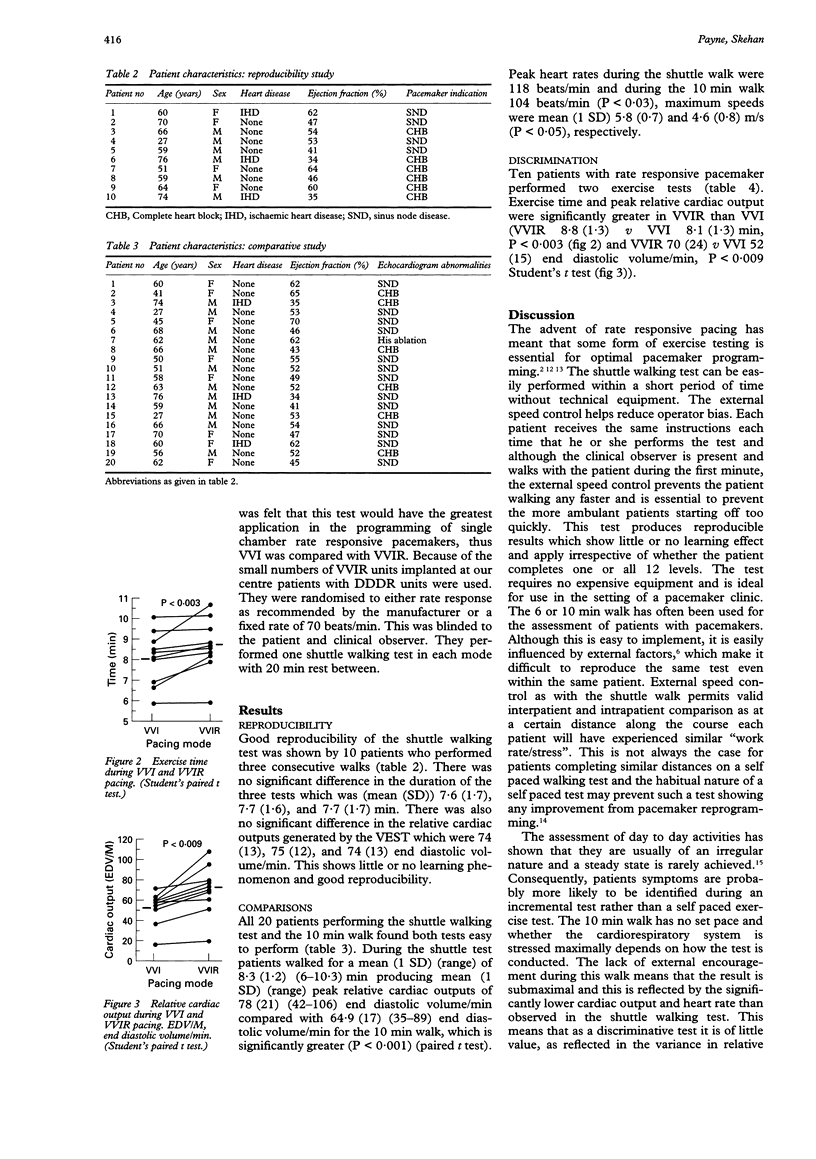
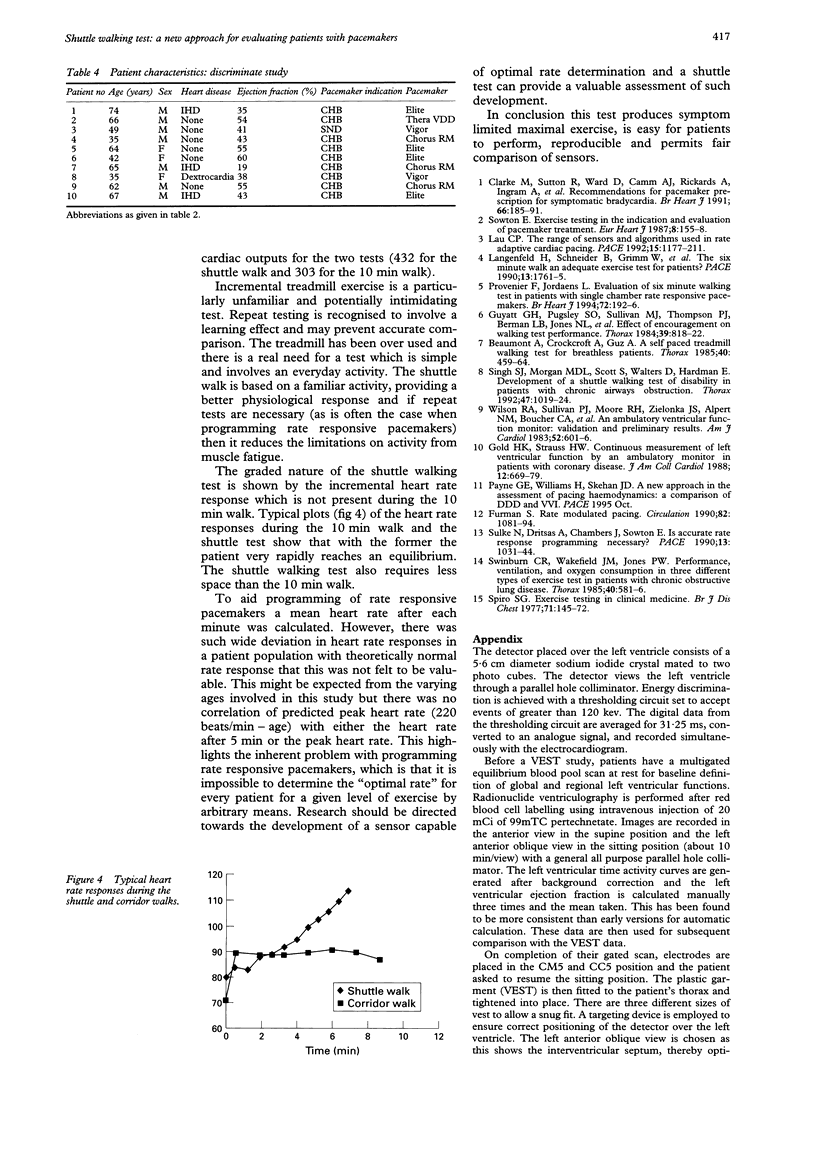
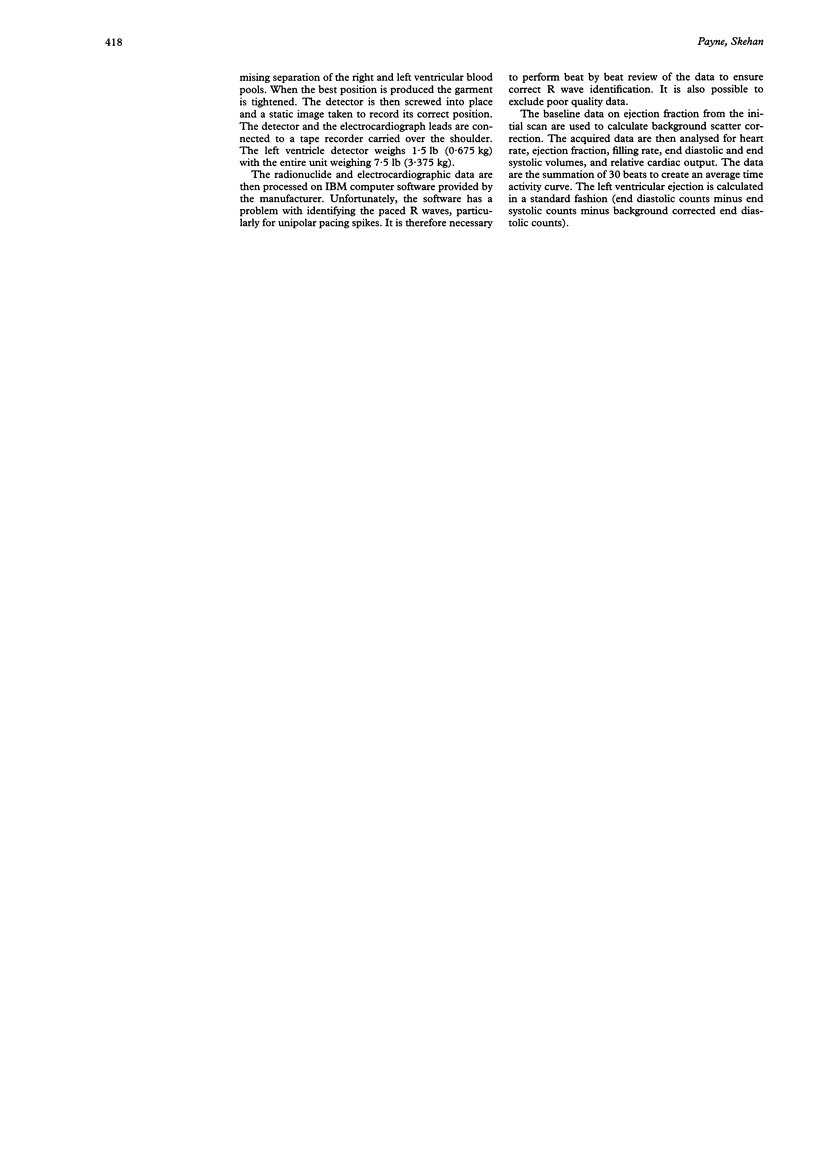
Selected References
These references are in PubMed. This may not be the complete list of references from this article.
- Beaumont A., Cockcroft A., Guz A. A self paced treadmill walking test for breathless patients. Thorax. 1985 Jun;40(6):459–464. doi: 10.1136/thx.40.6.459. [DOI] [PMC free article] [PubMed] [Google Scholar]
- Furman S. Rate-modulated pacing. Circulation. 1990 Oct;82(4):1081–1094. doi: 10.1161/01.cir.82.4.1081. [DOI] [PubMed] [Google Scholar]
- Guyatt G. H., Pugsley S. O., Sullivan M. J., Thompson P. J., Berman L., Jones N. L., Fallen E. L., Taylor D. W. Effect of encouragement on walking test performance. Thorax. 1984 Nov;39(11):818–822. doi: 10.1136/thx.39.11.818. [DOI] [PMC free article] [PubMed] [Google Scholar]
- Langenfeld H., Schneider B., Grimm W., Beer M., Knoche M., Riegger G., Kochsiek K. The six-minute walk--an adequate exercise test for pacemaker patients? Pacing Clin Electrophysiol. 1990 Dec;13(12 Pt 2):1761–1765. doi: 10.1111/j.1540-8159.1990.tb06886.x. [DOI] [PubMed] [Google Scholar]
- Lau C. P. The range of sensors and algorithms used in rate adaptive cardiac pacing. Pacing Clin Electrophysiol. 1992 Aug;15(8):1177–1211. doi: 10.1111/j.1540-8159.1992.tb03121.x. [DOI] [PubMed] [Google Scholar]
- Provenier F., Jordaens L. Evaluation of six minute walking test in patients with single chamber rate responsive pacemakers. Br Heart J. 1994 Aug;72(2):192–196. doi: 10.1136/hrt.72.2.192. [DOI] [PMC free article] [PubMed] [Google Scholar]
- Recommendations for pacemaker prescription for symptomatic bradycardia. Report of a working party of the British Pacing and Electrophysiology Group. Br Heart J. 1991 Aug;66(2):185–191. [PMC free article] [PubMed] [Google Scholar]
- Singh S. J., Morgan M. D., Scott S., Walters D., Hardman A. E. Development of a shuttle walking test of disability in patients with chronic airways obstruction. Thorax. 1992 Dec;47(12):1019–1024. doi: 10.1136/thx.47.12.1019. [DOI] [PMC free article] [PubMed] [Google Scholar]
- Sowton E. Exercise testing in the indication and evaluation of pacemaker treatment. Eur Heart J. 1987 Aug;8 (Suppl 500):155–158. doi: 10.1093/eurheartj/8.suppl_d.155. [DOI] [PubMed] [Google Scholar]
- Spiro S. G. Exercise testing in clinical medicine. Br J Dis Chest. 1977 Jul;71(3):145–172. doi: 10.1016/0007-0971(77)90106-1. [DOI] [PubMed] [Google Scholar]
- Sulke N., Dritsas A., Chambers J., Sowton E. Is accurate rate response programming necessary? Pacing Clin Electrophysiol. 1990 Aug;13(8):1031–1044. doi: 10.1111/j.1540-8159.1990.tb02150.x. [DOI] [PubMed] [Google Scholar]
- Swinburn C. R., Wakefield J. M., Jones P. W. Performance, ventilation, and oxygen consumption in three different types of exercise test in patients with chronic obstructive lung disease. Thorax. 1985 Aug;40(8):581–586. doi: 10.1136/thx.40.8.581. [DOI] [PMC free article] [PubMed] [Google Scholar]
- Tamaki N., Yasuda T., Moore R. H., Gill J. B., Boucher C. A., Hutter A. M., Jr, Gold H. K., Strauss H. W. Continuous monitoring of left ventricular function by an ambulatory radionuclide detector in patients with coronary artery disease. J Am Coll Cardiol. 1988 Sep;12(3):669–679. doi: 10.1016/s0735-1097(88)80054-8. [DOI] [PubMed] [Google Scholar]
- Wilson R. A., Sullivan P. J., Moore R. H., Zielonka J. S., Alpert N. M., Boucher C. A., McKusick K. A., Strauss H. W. An ambulatory ventricular function monitor: validation and preliminary clinical results. Am J Cardiol. 1983 Sep 1;52(5):601–606. doi: 10.1016/0002-9149(83)90034-6. [DOI] [PubMed] [Google Scholar]


